Delta II
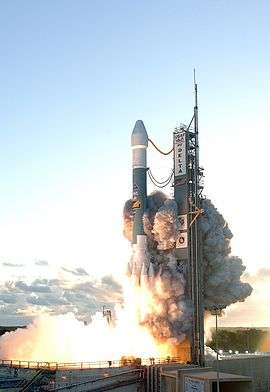 A Delta II rocket launches from Cape Canaveral carrying the Dawn spacecraft. | |
| Function | Launch vehicle |
|---|---|
| Manufacturer | United Launch Alliance (Boeing IDS) |
| Country of origin | United States |
| Cost per launch | US$51 million in 1987 (7920-10 mod.)[1] |
| Size | |
| Height | 38.2–39 m (125–128 ft) |
| Diameter | 2.44 m (8 ft 0 in) |
| Mass | 151,700–231,870 kg (334,440–511,190 lb) |
| Stages | 2 or 3 |
| Capacity | |
| Payload to LEO | 2,700–6,100 kg (6,000–13,400 lb) |
| Payload to GTO | 900–2,170 kg (1,980–4,780 lb) |
| Payload to HCO | 1,000 kg (2,200 lb) |
| Launch history | |
| Status |
|
| Launch sites |
Cape Canaveral SLC-17 Vandenberg AFB SLC-2W |
| Total launches |
153 Delta 6000: 17 Delta 7000: 130 Delta 7000H: 6 |
| Successes |
151 Delta 6000: 17 Delta 7000: 128 Delta 7000H: 6 |
| Failures | 1 (Delta 7000) |
| Partial failures | 1 (Delta 7000) |
| First flight |
|
| Last flight | |
| Boosters (6000 Series) - Castor 4A | |
| No. boosters | 9 |
| Motor | Solid |
| Thrust | 478 kN (107,000 lbf) |
| Specific impulse | 266 s |
| Burn time | 56 s |
| Fuel | HTPB |
| Boosters (7000 Series) - GEM 40 | |
| No. boosters | 3, 4, or 9 |
| Motor | Solid |
| Thrust | 492.9 kN (110,800 lbf) |
| Specific impulse | 274 s |
| Burn time | 64 s |
| Fuel | HTPB |
| Boosters (7000 Heavy) - GEM 46 | |
| No. boosters | 9 |
| Motor | Solid |
| Thrust | 628.3 kN (141,200 lbf) |
| Specific impulse | 278 s |
| Burn time | 75 s |
| Fuel | HTPB |
| First stage - Thor/Delta XLT(-C) | |
| Engines | 1 RS-27 (6000 series) or RS-27A (7000 series)[2] |
| Thrust | 1,054 kN (237,000 lbf) |
| Specific impulse | 302 s |
| Burn time | 265 s |
| Fuel | RP-1/LOX |
| Second stage - Delta K | |
| Engines | 1 AJ10-118K |
| Thrust | 43.6 kN (9,800 lbf) |
| Specific impulse | 319 s |
| Burn time | 431 s |
| Fuel | Dinitrogen tetroxide/Aerozine |
| Third stage - PAM-D (optional) | |
| Motor | Star 48B |
| Thrust | 66 kN (15,000 lbf) |
| Specific impulse | 286 s |
| Burn time | 87 s |
| Fuel | HTPB |
Delta II is an American space launch system, originally designed and built by McDonnell Douglas. Delta II is part of the Delta rocket family and entered service in 1989. Delta II vehicles included the Delta 6000, and two Delta 7000 variants ("Light" and "Heavy").
History
In the early 1980s, all United States expendable launch vehicles were planned to be phased out in favor of the Space Shuttle, which would be responsible for all government and commercial launches. Production of Delta, Atlas-Centaur, and Titan 34D had ended.[3] The Challenger disaster of 1986 and the subsequent halt of Shuttle operations changed this policy, and President Ronald Reagan announced in December of that year that the Space Shuttle would no longer launch commercial payloads, and NASA would seek to purchase launches on expendable vehicles for missions that did not require crew or Shuttle support.[4] McDonnell Douglas, at that time the manufacturer of the Delta family, signed a contract with the U.S. Air Force in 1987 to provide seven Delta IIs. These were intended to launch a series of GPS Block II satellites, which had previously been manifested for the Space Shuttle. The Air Force exercised additional contract options in 1988, expanding this order to 20 vehicles, and NASA purchased its first Delta IIs in 1990 for the launch of three Earth-observing satellites.[5][6] The first Delta II launch occurred in 1989, with a Delta 6925 boosting the first GPS Block II satellite into a 20,000 km high orbit.
The first Delta II 7000-series flew in 1990, replacing the RS-27 engine of the 6000-series with the more powerful RS-27A. Additionally, the steel-cased Castor 4A solid boosters of the 6000 series were replaced with the composite-cased GEM 40. All further Delta II launches except three were of this upgraded configuration, and the 6000-series was retired in 1992.[7]
McDonnell Douglas began Delta III development in the mid-90s as increasing satellite mass required more powerful launch vehicles.[5] Delta III, with its liquid hydrogen second stage and more powerful GEM 46 boosters, could bring twice as much mass as Delta II to geostationary transfer orbit (GTO), but a string of two failures and one partial failure, along with the development of the much more powerful Delta IV, lead to the cancellation of Delta III program.[8] The upgraded boosters would still find use on the Delta II, leading to the Delta II Heavy.
In total, the Delta II family has launched 153 times. Its only unsuccessful launches have been Koreasat-1 in 1995, a partial failure caused by one booster not separating from the first stage, which resulted in the satellite being placed in a lower than intended orbit,[9] and another failure in 1997 when a Delta II carrying GPS IIR-1 exploded 13 seconds after launch when a damaged SRB casing ruptured and triggered the vehicle's flight termination system.[10] No one was injured, and the launch pad itself was not seriously impacted, though several cars were destroyed and a few buildings were damaged.[11]
In 2007, Delta II completed its 75th consecutive successful launch,[12] surpassing the 74 consecutive successful launches of the Ariane 4.[13] With the launch of SMAP in 2015, the Delta II has enjoyed 98 consecutive successful launches, with two more scheduled.[14][15] Should these launches be successful, the Delta II would achieve an unprecedented 100 consecutive launch successes.[16]
Vehicle description
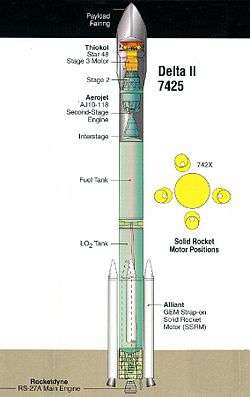
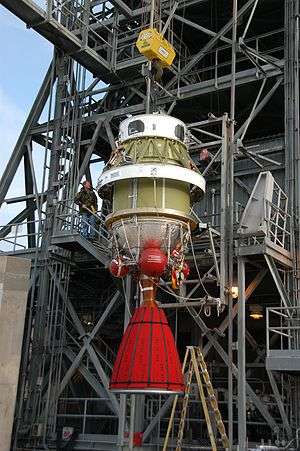
The first stage of the Delta II is propelled by a Rocketdyne RS-27 main engine burning RP-1 and liquid oxygen. This stage is technically referred to as the "Extra-Extended Long Tank Thor", a derivative of the Thor ballistic missile[17] as were all Delta rockets until the Delta IV. The RS-27 used on the 6000-series Delta II produced 915 kN,[18] while the upgraded RS-27A used by the 7000-series produces 1,054 kN.[19] The stage is 26 meters long and 2.4 meters wide, weighs over 100 t when fueled, and burns for 260 seconds.[20] In addition, two LR101-NA-11 vernier engines provide guidance for the first stage.
For additional thrust during launch, the Delta II uses solid boosters. For the 6000-series, Delta II used Castor 4A boosters, while the 7000-series uses Graphite-Epoxy Motors manufactured by ATK. The vehicle can be flown with three, four, or, most commonly, nine boosters. When three or four boosters are used, all ignite on the ground at launch, while models using nine boosters would ignite six on the ground, then the remaining three in flight after the burnout and jettison of the first six.[20]
The second stage of Delta II is the Delta-K, powered by a restartable Aerojet AJ10-118K engine burning hypergolic Aerozine-50 and N2O4. These propellants are highly toxic and corrosive, and once loaded the launch must occur within approximately 37 days or the stage will have to be refurbished or replaced.[21] This stage also contains a combined inertial platform and guidance system that controls all flight events. The Delta-K stage is 6 meters long and 2.4 meters wide, contains up to 6 t of propellant, and burns for up to 430 seconds.[20]
For low Earth orbit, Delta II is not equipped with a third stage. Payloads bound for higher energy orbits such as GTO or to reach Earth escape velocity for trans-Mars injection or other destinations beyond Earth use a solid propellant third stage. This stage is spin-stabilized and depends on the second stage for proper orientation prior to stage separation, but was sometimes equipped with a nutation control system to maintain proper spin axis.[22] It also included a yo-weight system to induce tumbling in the third stage after payload separation to prevent recontact, or a yo-yo de-spin mechanism to slow the rotation before payload release.[22]
Naming system
The Delta II family uses a four-digit system to generate its technical names:[23]
- The first digit is either 6 or 7, denoting the 6000- or 7000-series Deltas.
- The second digit indicates the number of boosters.
- The third digit is 2, denoting a second stage with an Aerojet AJ10 engine. Only Deltas prior to the 6000-series used a different engine, the TR-201.
- The last digit denotes the third stage. 0 denotes no third stage, 5 indicates a Payload Assist Module (PAM) stage with Star 48B solid motor, and 6 indicates a Star 37FM motor.
- An H following the four digits denoted that the vehicle used the larger Delta III GEM-46 boosters. The Heavy variant could be launched only from Cape Canaveral, and was retired with the closure of that launch site in 2011.[15]
For example, a Delta 7925H used an RS-27A, nine GEM-46 boosters, and a PAM third stage. A Delta 7320 is a two-stage vehicle with three GEM-40 boosters and no third stage.
Launch description
- Launch vehicle build-up
- A Delta II launch vehicle is assembled vertically on the launch pad. Assembly starts by hoisting the first stage into position. The solid rocket boosters are then hoisted into position and mated with the first stage. Launch vehicle build-up then continues with the second stage being hoisted atop the first stage.[24]
- Fueling
- It takes approximately 20 minutes to load the first stage with 37,900 liters (10,000 U.S. gal) of fuel.[25]
At T-45 minutes, fueling completion is confirmed. At T-20 minutes, the FTS pyros are armed. At T-20 minutes and T-4 minutes, there are built in holds. During these holds, final checkouts are performed. At T-11 seconds SRB igniters are armed. Ignition is at T-0.4 seconds. The ascent profile varies between missions.
Delta II launches
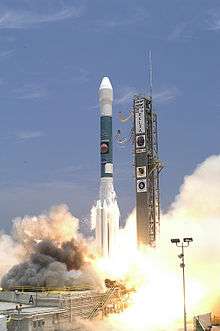

Notable payloads
- 2001 Mars Odyssey
- CONTOUR
- Dawn
- Deep Impact
- Deep Space 1
- GLAST
- Genesis
- GRAIL
- Gravity Probe B
- Kepler
- Mars Climate Orbiter
- Mars Exploration Rovers
- Mars Global Surveyor
- Mars Pathfinder
- Mars Phoenix
- Mars Polar Lander
- MESSENGER
- NEAR
- Jason-2
- Polar (satellite)
- ROSAT
- Spitzer Space Telescope (SIRTF)
- STEREO
- STSS-ATRR
- Swift
- THEMIS
- USA 193 (NROL-21)
- WIND
- WISE
- WMAP
Additionally, the Delta II launched several NASA missions to Mars:
- Mars Global Surveyor in 1996
- Mars Pathfinder in 1996
- Mars Climate Orbiter in 1998
- Mars Polar Lander in 1999
- Mars Odyssey in 2001
- Mars Exploration Rovers (MER-A, Spirit and MER-B, Opportunity) in 2003
- Mars Phoenix Lander in 2007
Furthermore, between May 1997 and November 1998, Delta II vehicles placed 55 Iridium satellites into orbit.[26]
Post MLV-3
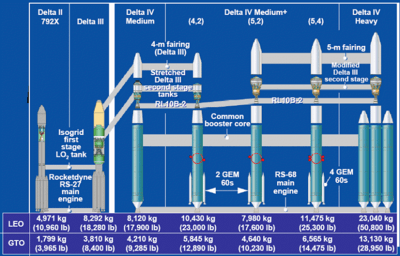
A 2007 article published by the Wall Street Journal speculated about the fate of the Delta II launch system after the U.S. Air Force discontinues its use of the Delta II.[27] Thomas Young, who was director of Goddard Space Flight Center from 1980 to 1982, is quoted as saying, "It's definitely an item people are quite worried about."
As of January 2015, two further Delta II launches are scheduled; the JPSS-1 and ICESat-2 satellites in 2017 and 2018.[15][28][29] ULA had previously indicated that it had "around half a dozen" unsold Delta II rockets on hand.[30] A spokesperson indicated that ULA will change some aspects of the Delta II system once the current MLV-3 contract (Medium-lift launch vehicle) with the Air Force ends and requirements imposed by the contract are lifted. The Air Force contract required that Delta II be kept ready to launch within 40 days of call up, which led ULA to maintain two launch pads at Cape Canaveral. ULA indicated it would not continue to operate two launch pads.[30]
In August 2009, the NASA assistant associate administrator for the Launch Services Program stated that NASA might purchase additional Delta II launches beyond those it had planned at that time.[31] However, on September 30, 2011, NASA modified the NASA Launch Services II (NLS-II) contract[32] to allow for the continuing order of Delta II launchers in agreement with ULA. Components for five additional Delta II vehicles had been built and two now remain unassigned to planned flights.[33] Under the terms of the revised NLS-II contract, only three Delta II configurations are available – the 7320-10, 7420-10 and 7920-10 – and launches are only available from SLC-2W at Vandenberg Air Force Base.[34] ULA has continued to update its product website[35] and continues to state that the vehicle is available for order for commercial or government offices.[36]
On July 16, 2012 NASA selected the Delta II for the launch of Soil Moisture Active Passive (SMAP), Orbiting Carbon Observatory-2 (OCO-2) and Joint Polar Satellite System-1 (JPSS-1) spacecraft. OCO-2 was launched on July 2, 2014 and SMAP was launched on January 31, 2015.[37] Both launches were aboard Delta II rockets placed into orbit from Complex 2 at Vandenberg Air Force Base in California.[38] JPSS-1 is scheduled for launch in early 2017.
Comparable rockets
See also
References
- ↑ "Archived copy". Archived from the original on July 14, 2014. Retrieved July 1, 2014.
- ↑ "Archived copy". Archived from the original on November 3, 2006. Retrieved November 3, 2006.
- ↑ Dawson, Virginia (2004). Taming Liquid Hydrogen (PDF). p. 233.
- ↑ "Reagan Orders NASA To Halt Launch of Commercial Payloads". Associated Press. Aug 16, 1986.
- 1 2 Rumerman, Judy (2009). NASA Historical Data Book, Vol. VII: NASA Launch Systems, Space Transportation, Human Spaceflight, and Space Science, 1989-1998 (PDF). NASA. pp. 49–51. NASA SP-4012.
- ↑ "Delta II, Atlas II" (PDF). U.S. Air Force. May 2003. Retrieved 28 June 2013.
- ↑ "ULA Delta II successfully lofts OCO-2 to orbit". NASASpaceflight.com. July 2, 2014. Retrieved July 26, 2014.
- ↑ "Delta III Data Sheet". Space Launch Report. Retrieved July 2014. Check date values in:
|access-date=(help) - ↑ Krebs, Gunter Dirk. "Koreasat 1, 2 (Mugungwha 1, 2) / Europe*Star B".
- ↑ The Deadly Aftermath of a Rocket Explosion Seconds After Launch Archived February 12, 2009, at the Wayback Machine.
- ↑ "Unmanned rocket explodes after liftoff". CNN.com. 1997-01-17. Retrieved 2009-03-31.
- ↑ "DigitalGlobe Successfully Launches Worldview-1". DigitalGlobe.
- ↑ Ray, Justin. "Mission Status Center (Delta 326)". Spaceflight Now. Retrieved 2007-09-26.
- ↑ "Workhorse Delta 2 returns to launch NASA observatory". Spaceflight Now. Retrieved July 2014. Check date values in:
|access-date=(help) - 1 2 3 Graham, William (July 2, 2014). "ULA Delta II successfully lofts OCO-2 to orbit". NASASpaceflight.com. Retrieved July 23, 2014.
- ↑ "Delta II Data Sheet". Space Launch Report. Retrieved 31 January 2015.
- ↑ Space Launch Report
- ↑ "RS-27". Astronautix. Retrieved July 2014. Check date values in:
|access-date=(help) - ↑ "RS-27A". Astronautix. Retrieved July 2014. Check date values in:
|access-date=(help) - 1 2 3 "Delta II Data Sheet". Space Launch Report. Retrieved July 2014. Check date values in:
|access-date=(help) - ↑ Dr. Marc D. Rayman (2007-07-15). "DAWN Journal". JPL NASA. Retrieved 2008-09-06.
- 1 2 "Delta II Payload Planner's Guide 2007" (PDF). ULA. Retrieved 24 July 2014.
- ↑ Forsyth, Kevin S. (2007-08-10). "Vehicle Description and Designations". History of the Delta Launch Vehicle. Retrieved 2008-03-15.
- ↑ "Expendable Launch Vehicle Status Report". NASA. June 6, 2007.
- ↑ "Swift Launch Pad Activities". 2004-11-18.
- ↑ "Boeing Delta II to Launch New Additions to Iridium Constellation". Boeing. Archived from the original on May 3, 2008.
- ↑ Pasztor, Andy (2007-05-29). "Delta II's Fate Worries Nonmilitary Users". WSJ.
- ↑ "NASA Selects Launch Services Contract For Three Missions". MarketWatch. 16 July 2012. Retrieved 16 July 2012.
- ↑ "NASA Selects Launch Services for ICESat-2 Mission". NASA Kennedy Space Center. 22 February 2013. Retrieved 15 March 2013.
- 1 2 Berger, Brian (2008-06-30). "Delta 2 Rockets to Remain Competitive Until 2015". Space News.
- ↑ Stephen Clark (August 29, 2009). "NASA looking to solve medium-lift conundrum".
- ↑ "NASA Launch Services Program Update".
- ↑ Ray, Justin. "NASA gives the Delta 2 rocket a new lease on life". SpaceFlightNow. Retrieved 17 July 2012.
- ↑ "NASA Launch Services Program". Archived from the original on October 24, 2011.
- ↑ "Delta II website". Archived from the original on June 28, 2012.
- ↑ "2010 Delta II product card" (PDF). Archived from the original (PDF) on September 30, 2011.
- ↑ "Mission - Orbiting Carbon Observatory". Jet Propulsion Laboratory. Pasadena, California: NASA. 2015. Archived from the original on 2015-01-31. Retrieved 31 January 2015.
- ↑ "NASA Selects Launch Services Contract for Three Missions". NASA. 16 July 2012.
External links
![]() Media related to Delta II at Wikimedia Commons
Media related to Delta II at Wikimedia Commons
- Delta II page at Boeing.com
- Delta I, II und III launch data at Skyrocket.de
- History of the Delta launch vehicle
- Delta II Launch Weather Commit Criteria

